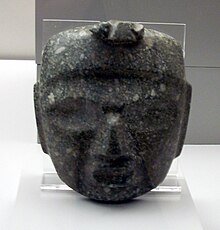


The Mezcala culture (sometimes referred to as the Balsas culture) is the name given to a Mesoamerican culture that was based in the southern Mexican state of Guerrero,[1] in the upper Balsas River region.[2] The culture is poorly understood but is believed to have developed during the Middle and Late Preclassic periods of Mesoamerican chronology,[1] between 700 and 200 BC.[2] The culture continued into the Classic period (c.250-650 AD) when it coexisted with the great metropolis of Teotihuacan.[3]
Archaeologists have studied the culture through limited controlled excavations, the examination of looted artifacts, and the study of Mezcala sculptures found as dedicatory offerings at the Aztec complex of Tenochtitlan.
